| |
Introduction
Pupils study music always focus in Baroque, Classical and romantic period, they usually neglect the music in twenty century. And most of them do not like twenty century music, also they feel strange and noisy of twenty century music; and pupils only know few characters about twenty century music: atonal, discord and chromatic notes.
Actually the music in twenty century is largely of exploration and experiment, and it also has a fascinating melody from the new trends, new techniques and sometimes the music in twenty century entirely new sounds. So pupils maybe cannot accept these all new things in twenty century music, but in music learning cannot neglect any different parts in music history, no matter like or do not like.
Impressionism, Atonality, Nationalism, Neoclassicism…are the new terms in the twenty century music, however, performance need extreme techniques; but pupils only need to study what are the meaning of these terms and hoe to play them successfully. Moreover, there are many different trends followed by twenty century music, and some of them be the complex mixture of style. Pupils study four main period of music, and they can find a great many characteristics of style which may identify in twenty century pieces.
In this assay, I will find out some characters always discover in twenty century music, and I classify these frequently characters in four topics: Melodies, Harmonies, Rhythms and Timbers; also I will show some music examples.
Melodies
This topic is for the ears, I investigate the sharp and the mood in the music, it is the first feeling of the twenty century music. And the melody is very importance, it is because pupils study the music with the first impression form its melody.
Harmonies
This topic is for the theory, I investigate the chord, cadence accompaniment, key and notes which use in the music, I like the analysis. It can help pupils to know why they always hear dissonances in twenty century music, also find out the harmonies can help us to understand what is the meaning in the music; which also the idea form the composer.
Rhythm
The topic back for the ears too, it related with phasing, pulse, tempo and dynamic, it like the investigation in melody of the music. But investigating rhythm is more detail than the investigating melody; because rhythm is both in the melody and accompaniment parts. Also it is the energy of the music, it give more hard feeling for he pupils.
Timbres
It also related to listening, but in more detail it is related with the touching and pedaling in the playing. That means it related to the technique of the performance playing. in this topic pupils can know how to practice twenty century music.
And there are many great composers in twenty century, such as Debussy, Bartok, Schoenberg, Shostakovich, Stravinsky, Prokofiev, Britten and so on. But I will only introduce some of them who are always meeting in pupil’s piano examination or performance piece, because it is more efficient to study twenty century music. the composers and the music pupils meet or chose in their examination, competition and performance are most meaningful for them, and they are willing to study more detail no matter they do not like.
On the other hand, the music pupils meet or chose in their examination, competition and performance must be more importance in twenty century music, also sometimes the music which in the syllabus of examination or competition with the specially study materials, examples are the form, mood, tone-color and the phase.
Study in twenty century music, I really want to understand the musical characters in this period and to improve the performance of this period piece. Also when I understand twenty century music it is promotion and development for the further study of music. And after this assignment and investigation, I want to state that music in twenty century also is the importance section in our music study life, pupils do not only focus in Baroque, Classical and Romantic period.
Great Composers in Twenty Century
- Prokofiev, Sergei Sergeievich (b.27 April 1891, d.5 March 1953)
He is a composer and pianist, studied with Glier and at the St. Petersburg Conservatory with Liadov, Rimsky-Korsakov, and N. Tcherepnin.
Works: opera *Love for Three Oranges, The fiery Angel, War and Peace, Romeo and Juliet, Tale of the Stone Flower…; orchestral *7symphonies, Scythian Suite, Peter and the Wolf, 6 piano concertos, concertos for violin and for cello, suites, overtures…
In many of Prokofiev’s works, especially his opera Love for Three Oranges, his Piano Concertos, Sonatas, and his ‘Classical’ Symphony-composed were in the Neoclassical style. Therefore Prokofiev explained ‘as Haydn might have written it if he had lived in our day’.
- Schoenberg, Arnold (b.2 Sept. 1874, d.13 April 1951)
He is composer and theorist, pupil of Zemlinsky, associate of R.Strauss, Mahler, and Kandinsky. Early in Schoenberg career composed within the German Romantic tradition influenced by both Brahms and Wagner, but 1907 was ready to abandon tonality. He developed the twelve-tone method.
Works: Chamber Symphony nos.1 and 2, Five Orchestral Pieces, Variations, concertos, chamber music includes *Verklarte Nacht, 4 string quartets, Serenade (8 instruments), Phantasy (violin and piano), and other choral music, songs with piano or instruments. Writing *Style and Idea, Harmonielehre, Structural Functions of Harmony.
Also Schoenberg and his pupil’s: Alban Berg and Anton Webern were written in Expressionist style and they work in Vienna, so these three became know as ‘The Second Viennese School’.
- Bartok, Bela (b.25 Mar. 1881, d.26 Sept. 1945)
He is a composer and ethnomusicologist, studied in Budapest Academy of Music where his teachers included: Thoman and Koessler, around 1906 Bartok and Kodaly began collecting folk songs in Hungarian villages, they collecting folk tunes, and then closely studying their rhythmic patterns and their melodies-often found to be based on unusual scales or modes. Bartok assimilated the spirit and substance of these melodies in his own music: Bartok’s Sonatina (based on Transylvanian folk tunes), Rumanian Folkdances
Works: String Quartet no.1, Piano Quintet, World War I composed piano suite and the Second String Quintet, and the ballet *The Wooden Prince, also he has a number of large piano works *the First Piano Concerto and the Sonata. Therefore Bartok pointed out ‘What we had to do was to discover the spirit of this unfamiliar music and make it the basis of our own works’. Also it was to become an essential element in Bartok’s style, especially in: Dance Suite, Music for Strings, Percussion and Celesta, and the Sonata for Two Pianos and Percussion.
In 1940 Bartok received a stipend to transcribe and classify Yugoslav folk song recordings. Also Bartok has many other works and many original sings and folk song arrangement.
- Shostakovich, Dmitri Dmitrievich (b.25 Sept. 1906, d.9 Aug. 1975)
He is a composer, studies at the Petrograd Conservatory under Steinberg. Shostakovich also as a pianist, he was winning honorable mention in the First International Chopin Competition in Warsaw in 1927. Shostakovich was nationalism in a narrower sense, and he has closely identified himself with his country in much of his music.
Works: 15 symphonies, several of which portray events in Soviet history *No.7 The Leningrad, No.11 The Year 1905, No.12 The Year 1917, other orchestral works *2 concertos each for piano, violin, and cello, choral works, chamber music and sonatas for violin, viola, and cello; also he has numerous songs and song cycles.
- Stravinsky, Igor Fyodorovich (b.17 June 1882, d. 6 April 1971)
He is a composer, third of four sons of Feodor Stravinsky. Stravinsky studied privately with Rimsky-Korsakov from 1902. Settled in Switzerland and continued to compose ballets; the first performance of *Le sacred u printemps (The Rite of Spring) and incited a colorful riot. Neoclassical style began evolving in the early 1920; also began appearing as conductor and pianist. *Apollon musagete or Apollo was the first of much collaboration with choreographer George Balanchine. In 1945, Stravinsky be a citizenship in U.S. he works *Symphony in Three Movements, the ballet Orphee, and the Mass for choir and winds crown his neoclassical symphonic, balletic, and liturgical oeuvres, respectively.
Works: many ballets and Operas *The Nightingale, The Rake’s Progress, The Soldier’s Tale, Ragtime, Symphonies of Wind Instruments, wind Octet, Concerto for Piano and winds, Violin Concerto in D and so on. Writings: Chroniques de ma vie (An Autobiography), Poetique musicle (Poetics of Music)
- Webern, Anton (b. 3 Dec. 1883, d. 15 Sept. 1945)
Studies musicology at University of Vienna, in 1904 met Arnold Schoenberg and become his disciple. Webern conducted light opera and operetta in Danzig, Stettin and else other; he produced first works under Schoenberg’s influence, and he wrote many settings of devotional verse. Webern worked with Society for Private Musical Performances, founded by Schoenberg and devoted to the performance of new music, conducted choruses. Also Webern adopted Schoenberg’s twelve-tone method in early 1920s. Therefore Webern is in ‘The Second Viennese School’, actually his works most influenced by his teacher Schoenberg. In 1945, Webern as an innocent bystander, shot and killed by an America soldier.
Works: Passacaglia op.1, six pieces for Orchestra op.6, six bagatelles p.9, three little pieces op.12 (cello and piano), five pieces for Orchestra op.10, five sacred songs op.15, string trio op.20, symphony op.21.
Music Character in Twenty Century
There are many elements in Twenty Century music, but these elements also have some similar or same ideas. Music in Twenty Century is like the continuing growth of musical styles which employed significant elements from national folk idioms, and the Neo-classicism, new discoveries of the early part of the century into musical styles having more or less overt connection with principles, forms, and techniques of the past; besides, the transformation of the German post-Romantic idiom into the twelve-tone styles. These are the main directions maybe the major idea or character in twenty century music.
French composers had functioned as very important force to bridge the romanticism and new direction of modernism. They do something to against German Romantic: Basic driving force in contemporary music is one of the reactions, composers’ development of nationalistic musical style and the inspiration from the Baroque music. Moreover, many composers looking back history, they think that historical periods were dominated and unified by certain composers form particular country; and the basic repertory; forms; idioms; and style they have provided. After these study and research, the composers in twenty century can develop new music and some new style.
Neo-classical (New Classicism), Neo-classicism
Neoclassicism is a style in Twenty Century music characterized by a strong reaction to the German Romantic (later Romanticism). It is more clearly revealed in ‘Pour le Piano’ and ‘Sonatina’ as to use the old forms of Prelude; Saraband; Minute and Toccata; Rounded binary; Dance rhythm; but employs the total new sound. Thick, congested textures for huge performing forces were replaced by clarity of line and texture characteristic of music wrote in the Romantic period before.
The typical forms and designs which rediscovered by Neoclassical composers were the toccata, passacaglia, concerto grosso, fugal forms and ostinato devices. And although Neoclassical composers looked to the past for inspiration, they also gave their music a very definite twenty century flavor: abrupt modulation, sudden melodic change, often containing some ‘wrong notes’ and discord, or use of polytonality. The textures are often polyphonic rather than homophonic, with clashing dissonances throwing the separate lines of counter pointer into sharp relief.
In Neoclassical, orchestras become limited in size, presenting instrumental timbres which are sharply contrasted. Also the Neoclassical style is often ‘cool’, composers emphasizing he sound of wind instruments and percussion rather than the more expressive strings.
However, differ composer have they own Neoclassical style, it is because music in twenty century are revive, composers did not want to follow an ideas or a formal structure in they music. Example like Stravinsky and Debussy, they both use the Neoclassical style in their music, but also have some difference details. Stravinsky’s neoclassical style related with balance, coolness, objectivity, and absolute music program. And he turned away from Russian folk music and back to earlier Western art music as a source for imitation, quotation, or allusion. Stravinsky was reworking a number of sonata movements and arias in a manner at once faithful to the older models and turn to his own sensibilities. Stravinsky most significant debt was to the eighteenth-century Classic tradition, period genres, forms, and styles served as prototypes for the Piano Sonata, the symphony and the serenade; and these basically diatonic works related to tonal centers and areas, not to major and minor keys or dominant-tonic polarities. Also this tonal style is typical in Stravinsky’s diatonic writing style.
Here’s the music example composed by Stravinsky, it is the Sonata for piano in the music Stravinsky use the Octatonic scales ( C D Eb F F# Ab A) through the piece,


And in the closing section, bass line also has the some augmented chord and augmented 3rd notes; although it is not acceptable in classical and romantic period, but this discord always in the 20th century music.

Beside these, in 20th century composers always add some 8va notes in the music, improve the music range, it seems the music more contrast and changeable, also it is one of the character of 20th century music. Example: upper melody line, lower E to E , G# to G# A# to A# and B# to B#.
And in neo-classical movement, composer always use contrapuntal concept of voice leading, individuality of phrasing of superimposed voices, also composers add many traits in common with the organ style of Bach. Example: Debussy ‘Reverie’ and ‘Arabesque no.1 in E’. There are many contrapuntal, right hand play a triplet and left hand play a regular quavers at same time, also in the music always has some four parts texture; the thick texture feel more like organ style and choral voice. The piece as below:
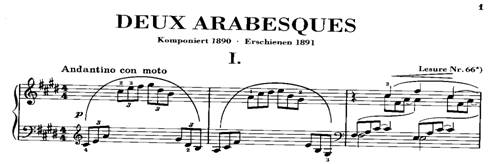

In the piece have contrapuntal and thick layer melody, let the music more vocal and harmony, it also the character in classical period.

Impressionism
A group of French painters developed a new style which came to be called impressionism; there are Monet, Manet, Degas, and Renoir …and it like the atmospheric, the composers also imitate the idea of painting, so be the new idea of 20th century music: impressions of light and color than sharply defined contours, the impressionism artists aimed to give merely an impression, like the eye might take in at a single glance; therefore impression of vague, hazy, outlines, and the play of shimmering light and movement. And musical impressionism is not devoid of romantic elements, and it may be described generally as having refinement, delicacy, vagueness, and an over-all ‘luminous fog’ characters.
And in impressionism, music always full with high-number chord, the chords for their expressive and color effect, moreover, these chords always the discords or similar chords (frequently 9ths or 13ths), also play these continues chords with moving in parallel motion. And the scales uses in the impressionism are modal scales, the five-note pentatonic scale, or the whole-tone scale.
Here the example of whole tone scales on C:
C D E F# G# A# B C
Also another great composer in impressionism is Ravel, in Ravel music is called the ‘classical impressionist’ It is different from Debussy that his music revealed the carefully delineated forms with a very clearly defined themes, cadences, and harmonic progression, its organization and the reflection that was more concentrates on the purely musical requirements rather than emotional aspects and extra musical association. So to speak that Ravel applied the impressionistic harmony, timbres and texture to the classical forms. His harmonic language is complex but in functional manner and always in fever of the classical formal clarity. Music examples: Sonatina, Menuet form Le Tombeau de Couperin (the principal neoclassical work).
Here are some church modes always use in the impressionisim:
Ionian C to C
Dorian D to D
Phrygigan E to E
Lydian F to F
Mixolydian G to G
Aeolian A to A
Locrian B to B
And the music Clair De Lune by Debussy, also the impressionism piece, composer state that it is the new world of sound is truly revealed, blurred pedal effects; the usage of sustained vibration-so the resonance may encounter the new harmonic notes, the employment of the triads with added sixth.
Also the music La Plus Que Lente is a very popular melodies are given freshness by subtle harmonies. La valse lento (the slow waltz) called in Paris of this music; it is a charming waltz and a popular tune. For performance: subtle amounts of rubato, allargando and contrasting animation must follow Debussy’s indications and the multiple curves and allusions of the melodies without losing the basic, and most danceable, Waltz spirit. In the music has long period of modal suspense, the forth holds us in suspense, and creating a strong feeling of waltz.
Here are the pieces selected:

Sixth chord
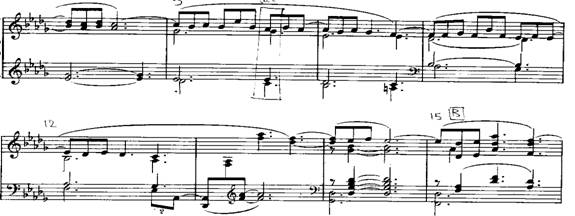
Hold base chord, open fifths and octaves

Also in the piece has the innovation in chord progression, parallel example: octave. And the arpeggios like the Bach prelude style.

However, impressionism is the importance music character in 20th century, it combination of the below devices: the use of neo-modality, open fifths and octaves, parallelism and other innovations in chord progression, the whole-tone scale, extensive use of the ninth chords, general vagueness of form, free rhythm and less prominence of bar-line regularity, flowing melodic lines, and wide spacing and the use of the extreme registers of the piano.
Polytonality and Atonality
In the music we refer to the key to find out the tonic. In the music written in C major, we will sense a strong trend towards the most important note of that key: the tonic note C and the next most important note is the dominant note G. But in 20th century, composers have experimented with the technique of polytonality- writing music in two or more keys at once. The example is the Stravinsky’s ballets Petrushka and the rite of spring, they are involves three keys at once: C, E and G., like a example below:
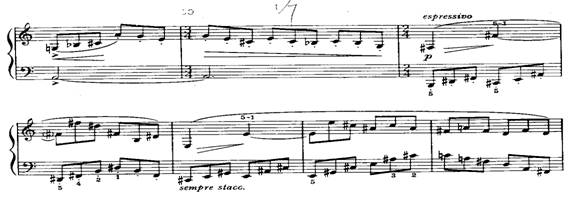

And the atonality means a total absence of tonality or key. Atonal music avoids any key or mode by making free use of all twelve notes of the chromatic scale. Atonality has not an importance note, therefore each twelve notes are given equal importance, and there is no pull towards any central tonic. Therefore some composers (like: Wagner) had freely use chromatic discords, it bringing in notes from outside the key to color the harmonies. It is the reason in 20th century, polytonality and atonality over the major and minor key system. Moreover, the development of polytonality and atonality maybe the use of parallel motion and the use of whole-tone scale; they also have he same concept to avoid the key character, and all these steps led eventually become essential to the style of Expressionist. The whole-tone scale and polytonality example as below:
(Suite form Bartok)
Polytonality (top line melody C# minor, bass chord F minor)
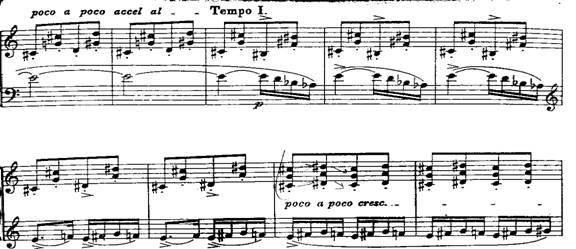
Whole-tone scale
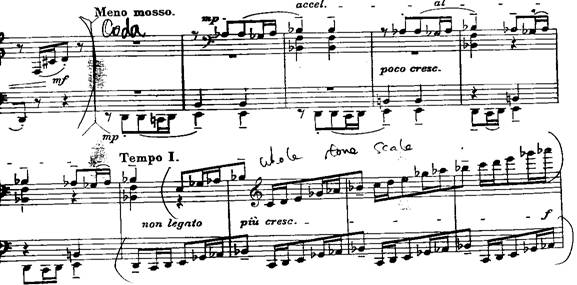
Expressionism
This also a term form painting, these painters expressed their innermost experience and states of mind: dark, secret terrors and fantastic visions of the subconscious. And expressionism in music began as an exaggeration, and distortion even, also composers poured the most intense emotional expressiveness into their music, therefore in 20th century music composers often use the mental breakdown to expressive their mind. Expressionist style composers are Arnold Schoenberg who is a painter too, and his pupils: Alban Berg and Anton Webern; they became know as ‘The Second Viennese School’.
Atonal styles, increasingly chromatic and total rejection of key or tonality are the character of expressionist music harmonies; composers use the extremely dissonant harmonies, frenzied, disjointed melodies (including wild leaps), violent tone color, and play explosive contrasts with instruments to expression to others.
Parallelism, Chromaticism and Serialism
Parallelism is an idea of all parallel intervals of fifth, third and octave. And the Chromaticism is another composition idea of inner part movement in chromatic, also the chord modulate by chromatic too. These two new composition concept is began in 20th century music, composers really want to break out the old style of music composition. Besides, Serialism or twelve note system is a composing which is a new arranges all twelve notes of the chromatic scale in order of the composer choice. It become the ‘note-row’, or the basic series which entire composition will be based, also all twelve notes are of equal importance, there are no any trendy to tonic, leading note and the pulling toward to the dominant. In this composition concept, the series of these notes have four difference form: original form, retrograde (backwards), inversion (upside down), retrograde inversion (backwards and upside down at the same time).
Here are the examples form Schoenberg – Variations for Orchestra, op 31


And the following are the Parallelism and Chromaticism:
Heitor Villa-Lobos – Mulatinha A Boneca De Borracha (selection)
Parallel fifth

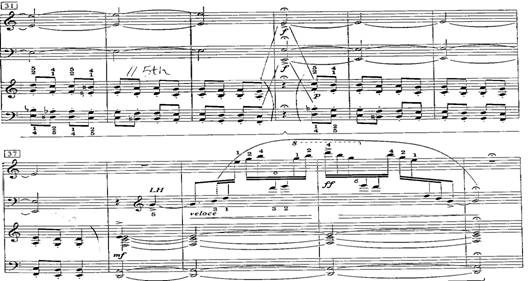
and parallel third and series parallel of chromatic chords (same piece)

Messiaen – Regard de la Vierge (Selective bars)
Parallel octave
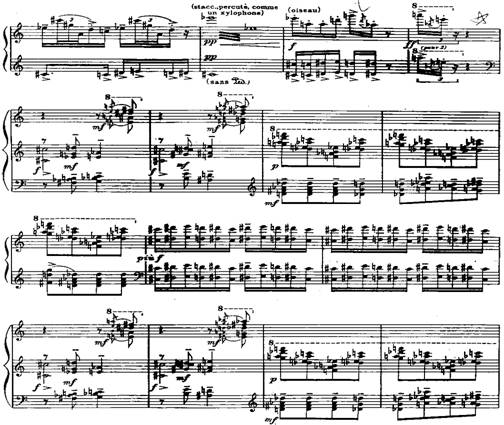
In these new composition concepts, composers accompanying harmonies consist of notes of the series stacked vertically to form chords.
Conclusion
Music in 20th century has many new materials and new ideas, therefore we have many new sounds in our music life today, also the period in 20th century hasn’t finish, that means will has more creative and shock news to us.
But to round up the development of early 20th century, there are Neo-classicism, impressionism, polytonality, atonality, expressionism, parallelism, Chromaticism and Serialism. These elements use to express the composes feeling, and all of the composers in 20th century are aims to break through the old musical style specially in romantic and classical period, therefore composers always avoid use the form and the characters which same as the music period before 20th century.
And in later 20th century musician in a special ways to develop new music, they directly onto magnetic tape rather than in an abstract way by writing notes down on paper. The sounds were the nature sounds around us, such as a door slamming, a cork popping from a bottle, and so on. And musician transferred these recordings to another tape: blending them, superimposing hem one on top of another, and modifying them in various ways, these maybe the new music of our future.
Study music not like study history or language, we cannot only remember the theory and the music style, also we cannot memorize all the pieces and music characters without enjoyment. Therefore I think we must refresh our memory about the characteristics of different styles of each period by learning a new musical period or new music style. It can help us more understand the new style, not only compare with two different music style and period, and we can discover that there are many creative in out 20th century music.
Bibliography
- Donald J.Grout, Claude V. Palisca A History of Western Music
- (New York. W.W. Norton company. 2001)
- J.Peter Burkholder, Donald J.Grout, Claude V. Palisca A History of Western Music(International Student Edition) (New York. W.W. Norton company. 2006)
- Roy Bennett History of Music(Cambridge, Cambridge university press, 2001)
- Don Michael Randel The Harvard Concise Dictionary of Music and Musicians (London, Harvard College, 1999)
- Marcus weeks Music (London, The Ivy Press, 1999)
- Roy Bennett Investigating Musical Styles(Cambridge, Cambridge university press, 2004)
|
|